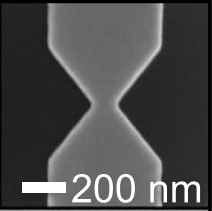We report on a method of nanoSQUID modulation which uses kinetic inductance rather than magnetic inductance to manip-ulate the internal fluxoid state. We produced modulation using injected current rather than an applied magnetic field. Using this injected current, we were able to observe the triangle-wave shaped modulation of the device critical current which was periodic according to the London fluxoid quantization condition. The measurement results also confirmed that the fluxoid state inside a superconducting loop can be manipulated using primarily kinetic inductance. By using primarily kinetic inductance rather than magnetic inductance, the size of the coupling inductor was reduced by a factor of 10. As a result, this approach may provide a means to reduce the size of SQUID-based superconducting electronics. Additionally, this method provides a convenient way to perform kinetic inductance characterizations of superconducting thin films.
McCaughan, A. N., Zhao, Q. & Berggren, K. K. nanoSQUID operation using kinetic rather than magnetic induction. Scientific Reports 6, 28095 (2016).
